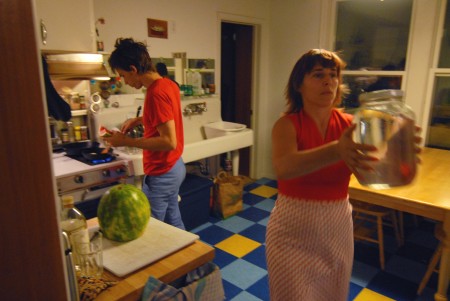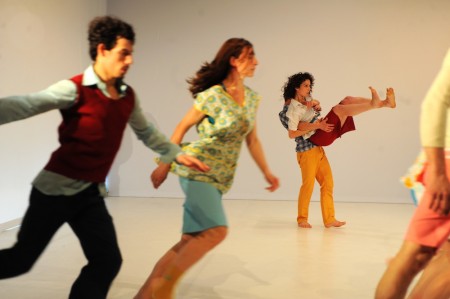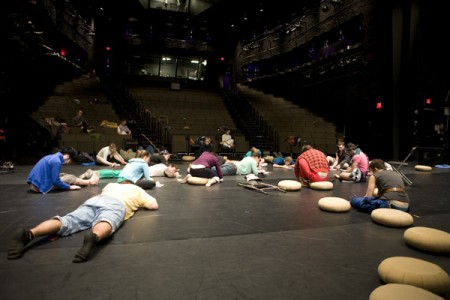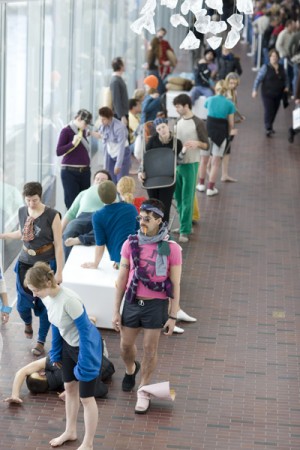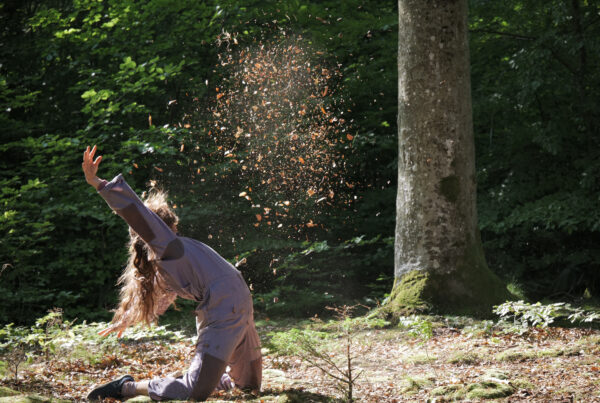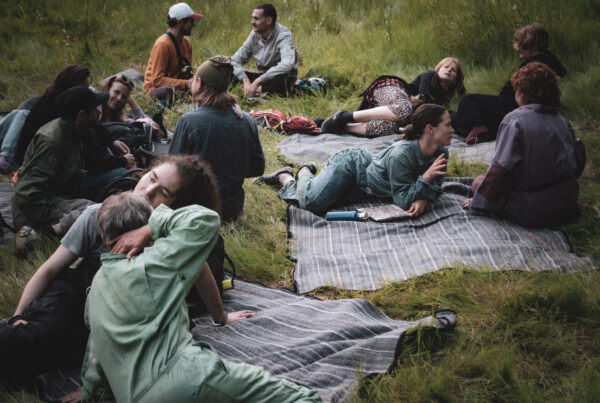Source: Magazine, Walker Art Center
Author: Michele Steinwald
Cutting-edge dance artists “tend to explore anything that transports them closer to the inside, closer to an understanding of how and why they work the way they do,” writes Gill Wright Miller, editor of Exploring Body-Mind Centering: An Anthology of Experience and Method. Olive Bieringa and Otto Ramstad, BodyCartography Project’s co-directors/choreographers, are two such artists. Their approach to creating dances is a layering of influences that is rooted in somatic techniques and philosophies. With attention to the micro (the body) and the macro (the community), the somatic values that BodyCartography Project employ in performance access a deep recognition of the power of the individual, on stage and in society, to make a difference and bond with an audience by invoking the viewers’ somatic response to their choreography. When dancers are grounded within thorough mind-body process, every aspect of the individual changes physically, aesthetically, socially, spiritually, and even physiologically, and these shifts are felt in performance.
Bieringa founded BodyCartography Project in 1997 in San Francisco and offered free weekly in-studio laboratories to explore improvisational practices for performance. Two years later, Ramstad joined the company as co-director. Together they have developed improvisational and set dance scores for outdoor happenings, dance films, site-specific performance installations, and stage presentations. I interviewed them together to discuss their creative approach at a highly productive time when BodyCartography Project was preparing for the world premiere of their group piece Super Nature, opening October 25, 2012, at the Walker Art Center.
While the BodyCartography duo and I are now part of the Twin Cities dance community, Bieringa and I once studied together as dancer/choreographers at the European Dance Development Center (EDDC) in Arnhem, Netherlands, in the early 1990s. Bieringa starts, “Post-modern dance training was a gateway to get into all these other source points or beginning points for me. The frame of dance is the creative field. How do we integrate it, play with it? How does it become our own? How do we use that? I am interested in an open field and getting into the idiosyncrasies of other peoples bodies and what is happening in their bodies in relationship.”
She continues, “Many techniques have come into our practice but it is hard to be really clear about what all the pieces are because they have become so integrated into my practice since Arnhem. Numerous somatic influences brought by the post-modern choreographers teaching at EDDC have become an interweaving of practices. Body-Mind Centering is now the main [investigation] in our process because it is so clear for accessing materials of the body, so straight forward, not simple but straight forward and easier to define than other forms. I had previously studied the body through many other forms like tai chi, shiatsu, traditional Chinese medicine, contact improvisation which was inspired by aikido, release technique, other postmodern dance traditions, and in addition, Otto has also studied capoeira which creates a certain type of mind-body integration, and all those pieces start to layer as approaches that we can easily categorize as not generating a certain style of moving but generate a certain way of focusing as a way of generating movement.”
The field of somatic inquiry emerged in the early twentieth century and has been applied to dance for some five decades. As Martha Eddy, Director of Somatic Studies at the Moving On Center and Director of the Center for Kinesthetic Education, explains in her seminal article, “When the dancing body is approached from a holistic perspective, which involves experiential inquiry inclusive of physical awareness, cognitive reflection, and insights from feelings, the dancing is somatic.” Somatics–from the Greek sōmatikos concerning the body, from the root sōma meaning body–is a loose grouping of body-based exercise or repatterning techniques, primarily therapeutic, that were initially developed through research and inquiry beginning just before the turn of the century and heavily evolved into the early twentieth century. The term was only later assigned to this trend of consciousness-raising body training techniques in the1970s by the philosopher and somatic practitioner Thomas Hanna.
“According to Hanna, somatics is the study of the soma, not as an objective ‘body,’ but an embodied process of internal awareness and communication,” clarifies University of North Carolina at Greensboro dance professor and Somatics scholar Jill Green in her research. “Process is an inherent concept in this field. In this sense, somatics focuses on an inner experiential body, not on a body as an objective entity or mechanical instrument. Further, some somatic theorists and educators move into a more macro sociopolitical sphere and address how our bodies and somatic experiences are inscribed by the culture in which we live.”
Both Bieringa and Ramstad are certified Body-Mind Centering (BMC) teachers. It is common for North American contemporary dancers to pursue a healing practice for insight into their own longevity as a performer in the dance field and as an additional source of income. Bieringa was introduced to BMC during her time at EDDC studying with Lisa Nelson; Ramstad began experimenting with dance improvisation and BMC at the age of six through the teaching ofSuzanne River. The founder of BMC, Bonnie Bainbridge Cohen was an occupational therapist, Certified Laban Movement Analyst, and dancer who developed the system in 1973 for accessing cellular consciousness through actions.
“It is empirical science,” Ramstad emphasizes. “It is based on many different people’s experiences, comparing and contrasting them over time. BMC has [methods] for identifying [patterns] and two big categories of how you approach the experience are by looking at anatomy books and then exploring [concepts] in order to have a new experience–one of the closest ways I have to experiencing new movement because you might be doing the same shapes, pathway or pattern of movement but getting at it through a new access point so it feels like a new movement–or identifying sensations that are familiar and then naming it. It is interesting for performance to privilege the dancer’s experience over the external bodily form. BMC takes such a long time to deeply get into the approach to gain the confidence of what you are experiencing; [it] can be from the cell membrane, for example. It seems impossible, like magic, before you have had enough experience with it to trust [the senses].”
In terms of building movement vocabulary in their new work, they rely on skills from BMC training to quickly provoke deep body awareness and original movement creation even if the dancers are not authentically performing BMC. Ramstad continues, “So with dancers in the piece, it would take a long time to build up the palette of experiences that you need to do certain things, you don’t have enough time. BMC is part of the process of making the piece which becomes more like set choreography. We are not asking people to perform BMC. If you are going to get on stage, there are so many factors happening that it would be very difficult to have a real detailed somatic experience–being able to deal with performing and remembering and being present for the others in the right timing–because there are so many other energetic elements to keep track of. If there was a reason then you could do it, but it would be a challenging thing to do. You would need to be fluidly moving through all those different ways of using your attention because there are so many factors in performance.”
With the artistic innovations of François Delsarte (1811–1871), Émile Jacques-Dalcroze (1865–1950), Rudolf Laban (1879–1958), Isadora Duncan (1878–1927), and Mary Wigman (1886–1973), the turn of the 20th century was a pivotal moment of artistic inventions. The application of somatic techniques to movement creation and performance was highly influenced by these individuals. Eddy confirms, “They shaped the culture in which the primary somatic pioneers were working. As dancers they were breaking rules; as people they were reintroducing non-Cartesian models.” Dancers became critical contributors to the second wave of somatics as practitioners and by creating over eleven of today’s most predominant somatic movement approaches from their work in dance. These techniques include Bartenieff Fundamentals, Body-Mind Centering, Continuum, EastWest Somatics, Ideokinesis, Anna Halprin’s contributions at the Tamalpa Institute, Kinetic Awareness, Patricia Bardi’s program in voice and dance integration, Skinner Releasing, Somatic Coaching, and the Topf Technique. By 1977, the American Dance Festival had moved to Duke University in Durham, North Carolina and integrating somatics into training workshops in their summer programs. This further integrated the natural evolution and relationship between professional dance pedagogy and somatics awareness. The benefits were clear as dancers were able to move more fluidly, efficiently, and expressively.
The field of Contemporary Dance increasingly demands more complex understanding and execution of performance and creation techniques. From BodyCartography Project’s perspective, even if the starting point for their movement scores are not purely BMC, they use BMC as a directorial device to bring out certain aspects in a performer, to amplify qualities, to identify what elements are missing, and to layer sensations (i.e. more ‘bones’ in order to create more extreme shapes). The BMC language becomes a tool that is useful for their choreography. Words like tensegrity (balance between tension and compression), turgidity (bloated), yielding (give under pressure), terms that are common in BMC work, are useful indicators for movement qualities explored in the studio. However, they often need to be explained to find a shared meaning. Bieringa elaborates, “Even with the word bones, you are recreating how people think about their bones because people think about their bones as dry brittle things, but actually they are living tissue full of blood and they bend and they are full of nerves and fluids, and so you are creating a new value system around each word you are using. It is this play between language and sensation and the gaming that exists within that process of BMC–of either naming something that is familiar or having new experiences and then putting names to them or pretending that you get it until you actually get somewhere–are tools that are super useful as part of our creative process.” This tension and dialogue created through somatic work is “a creative interplay.”
The fundamental somatic value of non-judgmental observation is fruitful when defining and instigating the impossible, and encouraging the exploration within that state from a fake-it-until-you-make-it stage in the creative process. Choreographers can amass plenty of choreographic material to draw on, plus also foster an environment of generosity amongst their cast and collaborators. Dancers contributing to the creative process through somatic exploration of states of deep embodiment of concepts and choreographic directives, such as in BodyCartography Project’s approach, need to provide feedback. This feedback will build a shared vocabulary and establish language for layering choreographic intentions in order to fine tune the final performance scores. Dancers in this environment are essential collaborators in building the content for the performance:
Their ‘truth’ is linked to their experience and as such their voice is a construction of their reality. Their multiple meanings are constructed, rather than found, according to their values, context and interests. Socio-constructivism emphasizes the collective generation and transmission of meanings.—Research in Dance Education
By empowering the individuals within a communal experience and drawing wisdom through bodily experiences, we open our communication up to each other and create a system of empathy and connection that challenges authoritarian and dominant meaning systems. Other contemporary choreographers use somatics and specifically BMC to inform their process. RoseAnne Spradlin utilizes BMC to make the dancers’ experience more essential, stripping them of layers of excess, information in order to expose their core as individuals. Choreographer and BMC practitioner Darcy McGeheemines the most subtle and obvious aspects of movement communication to promote the social contract within a performance.
In an interview the day after the world premiere of his latest group piece, Miguel Gutierrez credited somatics and their philosophical outcomes in the creative environment that produced this project. Gutierrez, “Making And lose the name of action for me was about tapping into the specialness of that present moment with those people, and the very specific contingency of those bodies in that time and in that situation, which feels like a somatic value, tapping into presence. Invested in the process of creation is an internal excavation. It is about sensitizing yourself to what is happening, sensitizing the situation, creating a shared body with the practitioners in room. Somatics inform that with a relationship to listening, a relationship to the politics of a situation, trying not to establish hierarchies.”
Gutierrez is currently pursuing certification to become a Feldenkrais practitioner. He acknowledges the values that were instilled in his creative process are being reconfirmed. Important to Gutierrez are Feldenkrais principles about not making assumptions about the situation, supporting what is already happening, supporting what is already present. He holds these same notions as strong directorial values while balancing a perception that is both based in specificity and globality. “Somatic values that come from somatic practices, like go micro and macro, have a holistic consciousness of what is happening in the piece. You need to be in a state of receptivity and physical preparedness for that.”
The somatics applications accessible to dance artists have elevated the expressive potential of dancers to new levels of potential as highly conscious individuals. The field of somatics has branched off into three categories of inquiry and application: somatic psychology, somatic bodywork, and somatic movement. At the core of somatic movement is ‘listening to the body’ and creating new pathways for movement experience by raising awareness of habits and exploring alternatives. Repatterning movement choices is extremely useful to expand the palette of options for a choreographer’s research and expanding a dancer’s range. The outcomes as internalized observations are innately beneficial to each person’s daily life as well as performance career. For Bieringa, “Everything is possible. It is possible to repattern your behavior. Bodies open up to that paradigm shifting, to bring in more fluid transitions, and create more ease. On a level beyond bodywork or dance making, it is a super useful tool for life and how can we apply that on bigger and bigger levels. How do we make use of that?”
Although Gutierrez romanticizes about the tyranny of a traditional theater director, he supports a caring environment to situate his dance process but wishes there were more examples of the “somatically kind” director. “As a director, my role is to share, not withhold. I found that it was such a weird gift to have these people willing to listen to me. I gave no homework so instead we researched everything together during our creative residencies. But I have to ask myself: What are you as a director or as a person in a piece? If nothing else, you are this energetic instigator. Why does a person need a director? What is different about a person taking charge of something versus things just happening?”
In Berlin, a collective with choreographers Isabelle Schad, Alice Chauchat, Frédéric de Carlo, Frédéric Gies and Odile Seitz, trained as Body-Mind Centering practitioners and presenting work under the name Practicable, are pushing that aspect of BMC and performance by letting more of the choreography just happen. The aesthetics of their works contain minimal design elements and the performers may or may not be trained dancers. The internal landscape of the
individuals in the cast become one whole as an external expression of the states they embody. BodyCartography Project’s use of BMC instructions and Gutierrez’s use of Feldenkrais principles are highly crafted theatrical events that embody values and creativity by deepening the physicality and dialogue of the contributing cast.
Gutierrez continues, “Their mode, what energy the performers can bring into the room, what they can actualize in the room between people, I am intrigued by that as a director and as a person. How can I disseminate a value that can be shared between people, to be experienced with each other?” Somatic values create community and teach us to be in community within the cast, within the performance, within the space, within the audience, and back to the cast. The feedback loop, based in a movement language and choreographic logic developed through somatic research, is palpable to all experiencing the work. Gutierrez says, “I think it is love. It has to be. I mean there has to be this sense of desire to want to participate to birth this thing together and to understand the time you are spending in a performance together. I can’t think of a word that is more appropriate. That is a big part of it. That is why what we do is so fucking weird.”
The truths that are housed in our bodies reveal unique and universal sensations to be shared in performance under the sensitive direction of somatic practitioners. While BMC has been a strong influence on their process of mining their dancers for material and shaping their choreographic scores to create fully formed states of expression, Bieringa adds a few other guiding principles passed along from her studies at EDDC, “An influence that I carry from Deborah Hay’s work is that moment of just ‘do the impossible.’ When you have this set of instructions that you don’t really know what it is and you just try to embody it, this list of words. There is something about that that I really love and have carried into my own work. And then Eva Karczag’s practice–coming out of the Alexander work but which is actually really BMC that she is doing in combination with Ideokinesis–that unknowing hands-on practice and the magic of the space that she would create in a classroom. It is really important to me in my generating and making dance practice to go there myself and be able to bring others to that space, the invitation and generosity to find their full engagement. Otto and I are not telling people what to do but bring ideas of things to try together. Those are key pieces that are still there.”
Somatics, as a loose collection of consciousness-building, body-based sensations with a goal towards a generous state of well being and bodily comfort even when pushed to the physical limits as a dancer in performance, can manifest into a residual behavior of self-betterment and community engagement. From Research in Dance Education,“Our heightened awareness has the potential to change the way we see the world around us and to render us more capable to act intentionally and effectively in it.” This next wave of somatically-inspired dance artists have the potential of great artistic expression and civic contribution. It is possible for the performances by BodyCartography Project for example to affect a deep transformation in the audience simply by their witnessing the actions on stage. Everyone can experience the pleasures of dance when viewers are somatically in tune with the values of these choreographers. By privileging the body-mind connection, dance literacy comes naturally and audiences with open hearts and mind have full access to the content and context of work performed. Although when a performance is produced and sourced from an internal experience, somatic-based choreography can seem less obvious to the average dance goer. However, since this work has been drawn from a shared process and displays both universal and personal bodily experiences, everyone is able to understand, simply by being present.
